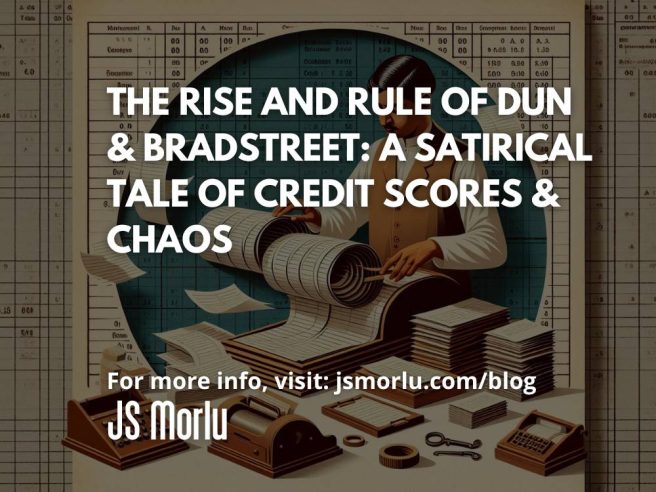By: John S. Morlu II, CPA
In the high-stakes, cutthroat world of business credit and information services, one name reigns supreme: Dun & Bradstreet (D&B). This global powerhouse, with roots stretching back nearly two centuries, has established itself as the ultimate gatekeeper of corporate legitimacy, shaping the fates of businesses from startup dreamers to multinational giants. With its vast reach, Dun & Bradstreet has become synonymous with corporate trustworthiness, data analytics, and, most importantly, the omnipotent D-U-N-S Number—the key that unlocks doors to government contracts, bank loans, and lucrative partnerships.
But let’s be real—D&B is no benevolent guardian. Behind its glossy reports and detailed credit scores lies a company that’s revered, feared, and, quite frankly, misunderstood. Much like the professor who knows everyone’s grades (and maybe enjoys reminding them of it), Dun & Bradstreet holds the power to dictate your business’s credibility. And that power comes with a price tag.
Dun & Bradstreet’s mission isn’t just to provide businesses with valuable insights into their financial health. Oh no, it’s also to monetize every shred of data they collect, offering monitoring services, credit reports, and “special insights” for the privilege of being told what you already knew: whether your business is a shining star or teetering on the edge of financial ruin. The kicker? Many businesses don’t even know they’re being tracked—until they’re asked to pay for the privilege.
Welcome to the world of business legitimacy, where your financial health is scrutinized, analyzed, and reported back to you, all while Dun & Bradstreet quietly collects its subscription fees. So, buckle up, because in this satirical dive into D&B’s empire, you’re about to discover how one company cornered the market on corporate surveillance—and how you might already be a part of their world without even knowing it. Oh, and don’t forget your wallet—because Dun & Bradstreet certainly won’t.
Chapter 1: The Birth of Dun & Bradstreet
Dun & Bradstreet’s origins are rooted in a time when people didn’t have the luxury of Googling “is this person shady?”—a dark age known as the 19th century. It all began in 1841 with a man named Lewis Tappan, who had an intense love for order, documentation, and probably color-coded ledgers. Tappan, a visionary businessman, realized that merchants had one common problem: trying to figure out if their customers were actually going to pay their bills, or if they were about to take a one-way stagecoach to Debt City, population: broke.
Armed with nothing but sheer organizational willpower, Tappan birthed what he called The Mercantile Agency, which, in its simplest form, was a centralized list of who’s broke, who might be broke, and who’s just plain dodgy. Merchants everywhere rejoiced. They no longer had to rely on the gut feelings of that one overly confident guy at the pub who swore he knew everyone’s financial business. Tappan had taken human intuition out of the equation and replaced it with cold, hard data. He had essentially created the Victorian version of Yelp—but for creditors.
Fast-forward to the roaring 1930s—a time of jazz, flappers, and completely unregulated finance. Here’s where things got spicy. By now, the credit-reporting scene had two heavyweight champions: R.G. Dun & Co. and The Bradstreet Company. Think of them as rival gangs in a West Side Story, but with less dancing and more credit scores. Their rivalry was fierce, as they fought for dominance in the thrilling world of…business credit reports. I know, right? But in 1933, these titans decided to bury the hatchet (or maybe the fountain pen) and merge to form Dun & Bradstreet—a corporate conglomerate so powerful, it would one day make even the most powerful companies quiver when their D-U-N-S Number was mentioned.
Now, let’s pause for a moment of appreciation here. Merging two credit-reporting companies may not sound like the stuff of legends, but in the corporate world, it was akin to Zeus and Poseidon joining forces—if instead of thunderbolts and tidal waves, they wielded financial documents and business reports. It was a match made in data heaven.
From these humble beginnings, Dun & Bradstreet evolved into the global behemoth we know today, extending its tendrils into over 240 countries and tracking the financial lives of more than 500 million businesses. That’s right, whether you’re running a billion-dollar enterprise or a lemonade stand with questionable inventory practices, D&B probably has your financial life in their crosshairs.
Over the decades, Dun & Bradstreet became a juggernaut, evolving beyond just checking if your customers were broke. They expanded into risk management, data analytics, and all manner of spooky financial wizardry. Need a detailed report on your business partner’s creditworthiness? D&B has it. Wondering if that vendor can be trusted? D&B knows. Want to know if your competition’s CEO is sweating at night over financial hiccups? Yep, D&B’s got the dirt.
And if that portfolio of services wasn’t enough to make them the overachieving student in the front row, D&B has one final weapon of corporate domination: the D-U-N-S Number.
Ah, the D-U-N-S Number—the crowning jewel in D&B’s treasure chest. To the uninitiated, the D-U-N-S Number might sound like some sort of secret spy code, but in reality, it’s even more powerful (especially if you’re a business). Think of the D-U-N-S Number as the social security number of the corporate world—except with more zeros and fewer government handouts. If your company wants to be taken seriously, especially when vying for government contracts or trying to cozy up to big financial institutions, you better have a D-U-N-S Number.
But here’s the kicker: the D-U-N-S Number isn’t just given out like free samples at Costco. No, no, no—this is Dun & Bradstreet’s exclusive VIP pass, and businesses have to jump through a few hoops to get one. It’s like being in a cool club where the only requirement for membership is your company’s complete and total financial transparency. Fun, right?
With the D-U-N-S Number, Dun & Bradstreet officially cornered the market on corporate credit legitimacy. The number became a necessity for any business with dreams of making it big. Government contracts? Better get that D-U-N-S. Loans from major banks? They’re going to want to see your D-U-N-S. It’s like the one ring to rule them all, except instead of Middle Earth, it rules spreadsheets and financial reports.
Today, Dun & Bradstreet sits atop the business data world like a stern headmaster, peering over its spectacles at the financial indiscretions of companies large and small. And yet, for all their knowledge and power, there’s a certain irony in the fact that this empire of creditworthiness was built on a foundation laid by Tappan’s little Mercantile Agency—just trying to keep tabs on some unreliable 19th-century customers.
Oh, how times have changed. But one thing remains constant: if you’re doing business, Dun & Bradstreet probably knows all about it. So, keep those balance sheets tidy and don’t forget—D&B is always watching.
Chapter 2: The D-U-N-S Code – Your Business’s Golden Ticket
Imagine the D-U-N-S Number as the VIP pass to the exclusive nightclub of the business world. It’s the glittering golden ticket that transforms your humble enterprise from a mere blip on the corporate radar into a legitimate, globally recognized entity with all the perks of membership. If you’re picturing Willy Wonka’s Chocolate Factory, but with spreadsheets and credit scores instead of Oompa Loompas and chocolate rivers, you’re on the right track.
The D-U-N-S Number—short for Data Universal Numbering System—sounds like something out of a sci-fi movie. It’s a nine-digit code issued by Dun & Bradstreet that allows businesses to create a unique global profile. Think of it as the Social Security Number of the business world, except instead of tracking your personal taxes, it’s tracking every financial move you make, from your first loan to your last financial report.
Now, let’s get real: the D-U-N-S Number is like the golden snitch in the game of Quidditch—everyone’s after it, and if you’ve got it, you’re winning. Governments, corporations, banks—they all use the D-U-N-S Number as their magical wand for verifying whether your business is the real deal or just a figment of someone’s imagination. It’s the corporate equivalent of a secret handshake that says, “Yep, we’re legit.”
Without a D-U-N-S Number, you’re not just another business—you’re like a ghost floating through the corporate ether. You might as well be running a lemonade stand in the middle of the desert with a sign that says, “Will Work for Visibility.” No D-U-N-S Number means no U.S. government contracts, no hefty business loans, and no big partnerships with those flashy corporations that everyone’s dying to team up with. You might be doing fantastic work, but in the business world’s grand theater, you’re an extra who didn’t make it past the audition.
Here’s the twist: technically, having a D-U-N-S Number isn’t required to run a business. It’s not like you need one to open a coffee shop or start a dog-walking service. But if you’ve got dreams of playing in the big leagues, rubbing shoulders with Fortune 500 companies, or snagging those government contracts that come with a side of taxpayer money, then you’d better get yourself a D-U-N-S Number. It’s not so much a requirement as it is a ticket to the front row of the business world’s hottest show.
And here’s the kicker: applying for a D-U-N-S Number is free. That’s right, free! Like a free sample at a grocery store—except, instead of a tiny bite of cheese, you’re getting a nine-digit code that says, “Hey, I’m a serious player.” But hold your applause because while the D-U-N-S Number itself doesn’t cost a dime, the real fun begins when you start exploring Dun & Bradstreet’s treasure trove of subscription services. Oh yes, after you’ve secured your D-U-N-S Number, you’ll find yourself serenaded with offers for all kinds of premium services. Want to keep a closer eye on your credit score? There’s a subscription for that. Need detailed analytics on your competition? Yep, there’s a plan for that too. It’s like they’re saying, “Welcome to the club. Now, let’s talk membership fees.”
So, picture this: you’ve got your D-U-N-S Number, your business is now a legitimate entity in the global marketplace, and you’re ready to take on the world. You’re no longer a shadow, no longer a ghost. You’re a business with a serious identity, a digital passport that says, “I’m here, I’m real, and I’m ready to do business.”
But remember, with great power comes great responsibility. Or, in this case, with great data comes great potential for additional fees. The D-U-N-S Number might have opened the door to new opportunities, but it’s Dun & Bradstreet’s subscription services that keep the lights on and the data flowing. It’s a beautiful dance of credibility and commerce—one where Dun & Bradstreet leads, and businesses follow, eager to prove their worth and willing to pay for the privilege.
So, as you embark on your journey through the corporate cosmos, keep your D-U-N-S Number handy. It’s your ticket to the big leagues, your badge of legitimacy, and your way to ensure you’re not just another face in the crowd but a serious player in the global business arena. And if you find yourself wondering why you’re paying for all those extra services, just remember: in the world of business, nothing says “I’m important” quite like a nine-digit code.
Chapter 3: Meet the Stars: Thomas Titan & Lucinda Ledger
In the dazzling, high-flying world of startup businesses, where dreams bounce as high as trampolines, we meet our unsuspecting hero: Thomas Titan, the visionary founder of Thomas Titan’s Thunderous Trampolines. Thomas isn’t your run-of-the-mill entrepreneur. Oh no, he’s a man on a mission to revolutionize team-building exercises with the incredible, the unparalleled, the most astonishing corporate trampoline rentals this side of the Milky Way. His motto? “If you’re not bouncing, you’re missing out!”
Thomas’s heart was as full as his trampolines were springy. He had a grand vision of office workers leaping for joy, literally, and turning corporate drudgery into dynamic, bouncy bliss. His trampoline installation skills were the stuff of legends—if legends involved a lot of enthusiastic jumping and the occasional somersault. But, as every startup guru knows, passion and trampoline skills alone won’t get you very far. You need capital. And that’s where Thomas’s dreams hit a little snag.
One fine day, Thomas strolled into Monolithic Bank with a bounce in his step and a business plan under his arm. He was ready to secure a loan that would help him spread the joy of trampolines far and wide. But as soon as he laid his plan on the desk of the head banker, Mortimer Moneygrubber, things took a turn for the worse. Mortimer was a man of distinction, with a monocle that sparkled like it was made of stardust and a demeanor that could freeze a lava flow.
“You don’t have a D-U-N-S number,” Mortimer announced with a flourish, as if he’d just revealed the secret to eternal youth.
“A what number?” Thomas asked, his eyebrows knitted in genuine confusion. He wasn’t exactly fluent in the language of corporate finance.
“A D-U-N-S number!” Mortimer repeated, his monocle nearly falling off in sheer horror at Thomas’s ignorance. “Without it, I can’t check your business credit, which means we can’t approve your loan.”
Thomas’s hopes deflated faster than a trampoline losing air. “But my business is about trampolines, not rocket science!” he protested. Mortimer’s answer was as cold as a polar bear in a freezer. “Without a D-U-N-S number, we have no way to verify your financial reliability. It’s like trying to bake a cake without knowing the recipe.”
And so, Thomas found himself at the doorstep of the modern-day fortress of financial wizardry—Dun & Bradstreet. With trepidation, he entered the imposing edifice, which was rumored to have more layers than a wedding cake and more security than a high-profile gala.
Inside, he encountered the most feared and revered sales executive in the entire Dun & Bradstreet empire: Lucinda Ledger. Lucinda was a high-ranking sales executive with a knack for selling ice to Eskimos and, of course, D-U-N-S numbers to everyone who walked through the door. Her sales prowess was legendary; she could convince a houseplant it needed a business credit report.
“Mr. Titan, it’s a pleasure to meet you,” Lucinda greeted, her smile as polished as her sales pitch. “With our Business Credit Advantage Plan, you’ll have access to comprehensive business monitoring, instant credit alerts, and a streamlined process for banks to check your creditworthiness. All this for just $149 a month!”
Thomas’s eyes widened. “$149 a month? For a trampoline business? Are you sure that’s necessary?”
Lucinda’s eyes twinkled with the kind of confidence only found in top-tier sales professionals. “Absolutely, Mr. Titan. Think of it as investing in your business’s future. We’ll ensure that your credit is monitored around the clock. Plus, banks will see you as a credible player in the corporate arena. It’s not just a number; it’s your ticket to credibility!”
Feeling as though he’d stumbled into a VIP lounge where everyone was partying about credit scores, Thomas signed up for the service. He had briefly wondered if his trampolines really needed as much credit monitoring as a hedge fund, but who was he to argue with Lucinda? After all, if Mortimer Moneygrubber had deemed it essential, and Lucinda was practically giving him the keys to the kingdom, then it must be a necessity.
And thus, Thomas Titan’s Thunderous Trampolines was equipped with the coveted D-U-N-S Number. Thomas could now bounce into the world of corporate legitimacy, ready to conquer the big leagues with the assurance that his business was monitored, analyzed, and checked by the mightiest of data giants.
Little did Thomas know, his journey into the world of Dun & Bradstreet was just beginning. The trampoline business may have been bouncing, but in the world of credit scores and financial legitimacy, there were many more adventures, and perhaps a few more fees, waiting just around the corner.
Chapter 4: The World of Subscriptions and Fees
Once Thomas Titan had bravely entered the realm of Dun & Bradstreet, armed with his brand-new D-U-N-S Number and a heart full of optimism, he was greeted with his very first D&B report. This report, a tome of corporate intricacies, laid bare every facet of his business credit: payment history, public filings, liens—everything but his childhood pets. Thomas was astounded, not just by the detail but by the labyrinthine nature of his new financial universe.
What Thomas didn’t quite grasp was that Dun & Bradstreet wasn’t just about providing a single service; they had curated a veritable buffet of subscription tiers, each with its own tantalizing offerings and price tags that could make your head spin faster than a trampoline in full bounce. Allow me to guide you through the fascinating, and somewhat bewildering, world of D&B’s subscription plans:
- CreditBuilder Plus: For the low, low price of $149 a month, you get the basics—credit monitoring, alerts, and access to rudimentary reporting tools. Think of it as the entry-level trampoline: functional, but not exactly designed to make you the star of the corporate circus.
- CreditBuilder Premium: If you’re feeling fancy and willing to fork out $199 a month, you step up to the deluxe package. This includes everything from the Plus plan but adds insights into your business’s financial health and enhanced analytics. And yes, there’s a shiny online badge that declares, “This Business Is Trusted,” making you look like the VIP of the business world. It’s essentially like trading up from a basic trampoline to one that sparkles and plays music.
- Business Risk Dashboard: For those who want to go all-in, there’s the high-roller option at around $349 per month. This plan not only includes comprehensive reports but also dives deep into your competitors, suppliers, and customers. Imagine having Sherlock Holmes as your financial consultant, minus the Victorian attire and the deerstalker hat, but with all the sleuthing skills. It’s like having a superpower that lets you peek behind the corporate curtains.
And just when Thomas thought he had seen it all, he was introduced to the myriad of add-ons for specific industries or global markets. Each add-on came with its own set of features and, of course, its own price tag. It was like a subscription menu at an upscale restaurant where the more you ordered, the more you paid. Dun & Bradstreet had morphed from a data provider into a lifestyle brand—one where the more you wanted to know, the deeper your pockets needed to be.
But perhaps the most mystifying part of Thomas’s new life was the relentless flood of promotional materials and offers that landed in his inbox and interrupted his already hectic trampoline setup. Every week, without fail, Lucinda Ledger would call him with an “exciting new offer” that made Thomas wonder if there was a trampoline version of financial overreach.
“Thomas, have you considered our Business Builder Plus Loan?” Lucinda’s voice was practically bubbling with enthusiasm.
Thomas, while elbow-deep in the assembly of an industrial-sized trampoline, was perplexed. “Lucinda, I rent trampolines. I don’t need a loan.”
Her response was as smooth as a bounce on a high-end trampoline. “Well, you never know when you’ll need a new delivery truck to haul those trampolines. Or perhaps a second trampoline park to expand your empire!”
Thomas, now entrenched in a sea of Dun & Bradstreet subscriptions and offers, couldn’t help but feel like he was in a never-ending game of financial Whack-a-Mole. Every time he thought he’d managed to get a handle on his expenses, another offer would pop up, promising to make his business—wait for it—more efficient, more secure, and, most importantly, more profitable.
Thomas’s struggle was real. He was shelling out more in subscriptions and fees than he had ever earned from renting out trampolines. The irony of it all was not lost on him. Here he was, trying to make people bounce with joy, while he was left bouncing from one fee to another, all in the name of financial security.
He began to wonder if Dun & Bradstreet had a secret strategy to keep him in a perpetual state of subscription. After all, every new service promised a better tomorrow, but only if he could afford to keep subscribing. It was a corporate carousel where the more Thomas tried to elevate his business, the more he felt like he was just spinning in circles, paying for the privilege.
As Thomas navigated the dizzying array of options, he realized one thing: Dun & Bradstreet might have promised to make his business shine, but they sure knew how to charge for the spotlight. The trampoline business was hopping along, but in the world of credit reports and subscription fees, Thomas was learning that sometimes, the real bounce comes from the bottom line.
Chapter 5: Dun & Bradstreet Today – The Corporate Behemoth
If Thomas Titan thought his trampoline business was a big deal, he hadn’t seen anything yet. Enter the realm of Dun & Bradstreet (D&B) in the modern age—a corporate colossus with the kind of market power that could make King Kong look like a housecat.
Today, Dun & Bradstreet is no longer just a quaint credit reporting service. Oh no, it’s a publicly traded juggernaut, dancing on the New York Stock Exchange under the ticker symbol DNB. As of 2023, this titan boasts a market capitalization of a jaw-dropping $8.6 billion. That’s billion with a B, and it’s enough to make even the most seasoned investor’s eyebrows shoot up in amazement.
In 2022, Dun & Bradstreet pulled in around $2.24 billion in revenue. And where does this impressive cash flow come from? Subscription fees, analytics services, and the sort of data-driven wizardry that might make even a magician blush. It’s not just Thomas Titan’s trampoline business that’s hooked; it’s banks, suppliers, and an army of corporate clients all eagerly handing over their hard-earned dollars for a peek into D&B’s treasure trove of information.
Imagine a database so vast it could make the Library of Congress look like a shoebox of receipts. That’s Dun & Bradstreet’s data empire, packed with everything from creditworthiness and payment histories to supply chain risks and market insights. This isn’t just data; it’s the stuff of corporate legend, a global network of 135,000 data sources all working tirelessly to keep businesses in check. If data were a sport, D&B would be the Michael Jordan of information.
But here’s where it gets really fascinating. D&B’s services are more than just valuable; they’re essential. Banks rely on them to assess creditworthiness, suppliers use them to vet potential partners, and government agencies—yes, the very same government that controls the keys to the federal coffers—depend on D&B to issue D-U-N-S Numbers. In essence, Dun & Bradstreet has become the gatekeeper of government business, making them the corporate equivalent of a bouncer at the VIP lounge of the business world.
With such power comes a level of influence that can make the average CEO’s head spin. It’s almost poetic how a company that began as a modest credit reporting agency has evolved into a global powerhouse, holding the keys to business legitimacy and financial stability for companies around the world.
So, when you think of Dun & Bradstreet today, don’t just picture a credit reporting service. Imagine a corporate behemoth that not only dominates the data landscape but also wields enough power to shape the very fabric of the business world. It’s a bit like David turning into Goliath, only with more spreadsheets and fewer slingshots.
In the grand theater of global commerce, Dun & Bradstreet doesn’t just play a role; it commands the stage, directing the action with a precision that could make a Swiss watchmaker envious. And as for Thomas Titan? Well, he’s still bouncing along, but now he knows that the real circus isn’t in his trampoline park; it’s in the towering, data-driven empire of Dun & Bradstreet.
Chapter 6: The Final Showdown
As Thomas Titan stood at the entrance of Dun & Bradstreet’s imposing headquarters, he felt like a lone knight challenging a dragon. His army of small business owners—each with their own war stories of subscription woes and unending fees—stood beside him, rallying behind a banner that read, “We Don’t Need Monitoring to Succeed!” It was a brave, if somewhat hapless, attempt to wrestle free from the data-driven clutches of the corporate colossus.
Their chant echoed through the lobby, a motley symphony of defiance that would have been more impressive if it weren’t for the nervous glances exchanged between the small business warriors. The entrance to D&B’s fortress was sleek, glassy, and oddly imposing, like a very expensive piece of modern art. Inside, the air was filled with the soft hum of data servers and the occasional clack of keyboards—sounds that seemed to mock their rebellion.
The coalition of small business owners had hoped to stage a grand protest, but their plans quickly unraveled. Within days of their ill-fated march, many of them received emails from Lucinda Ledger—D&B’s very own high-pressure sales guru. Her subject lines promised “personalized credit offers” and “exclusive business opportunities.” It was like being pursued by a relentless matchmaker, but instead of love, the offers were all about financial products they didn’t know they needed.
“Thomas, darling, did you see the new Business Enhancement Platinum Plan?” Lucinda’s email began, her enthusiasm practically leaping off the screen. “It’s perfect for ambitious entrepreneurs like you!”
Thomas, now more accustomed to the siren calls of D&B’s relentless marketing than he’d care to admit, sighed as he clicked the link to renew his D-U-N-S subscription for another year. His once bold vision of overthrowing the data overlords had fizzled into a resigned acceptance of his fate. “Maybe this time I’ll actually get that government contract,” he muttered to himself, casting a wistful glance at his trampoline setup. The thought of finally securing a federal contract seemed as distant as a trampoline landing on the moon.
The world of Dun & Bradstreet is a bit like a high-stakes game show where the prize is business legitimacy and the cost is a never-ending string of subscription fees. For better or worse, D&B has perfected the art of making businesses feel like they’re on a tightrope strung high above the abyss of financial obscurity. And as much as Thomas and his fellow small business owners tried to rebel, they found themselves back under the watchful eye of the data giant.
In the end, Dun & Bradstreet remains the omnipresent guardian of corporate credibility—a monolithic force that doles out data, monitors behavior, and wields a subscription model that feels as endless as the ocean. Whether you’re steering a multi-billion-dollar enterprise or simply trying to keep your trampoline rentals afloat, one thing is clear: you can’t escape the long arm of Dun & Bradstreet.
So, as Thomas Titan resumed bouncing along in his trampoline empire, he couldn’t help but marvel at the inescapable truth of the business world. Dun & Bradstreet might just be the most powerful force lurking behind the scenes, and no matter how hard one tries to dodge their grasp, the data giant’s reach is as inevitable as gravity. And in this great circus of commerce, everyone has a ticket—and a subscription—to the Dun & Bradstreet show.
Author: John S. Morlu II, CPA is the CEO and Chief Strategist of JS Morlu, leads a globally recognized public accounting and management consultancy firm. Under his visionary leadership, JS Morlu has become a pioneer in developing cutting-edge technologies across B2B, B2C, P2P, and B2G verticals. The firm’s groundbreaking innovations include AI-powered reconciliation software (ReckSoft.com) and advanced cloud accounting solutions (FinovatePro.com), setting new industry standards for efficiency, accuracy, and technological excellence.
JS Morlu LLC is a top-tier accounting firm based in Woodbridge, Virginia, with a team of highly experienced and qualified CPAs and business advisors. We are dedicated to providing comprehensive accounting, tax, and business advisory services to clients throughout the Washington, D.C. Metro Area and the surrounding regions. With over a decade of experience, we have cultivated a deep understanding of our clients’ needs and aspirations. We recognize that our clients seek more than just value-added accounting services; they seek a trusted partner who can guide them towards achieving their business goals and personal financial well-being.
Talk to us || What our clients says about us







